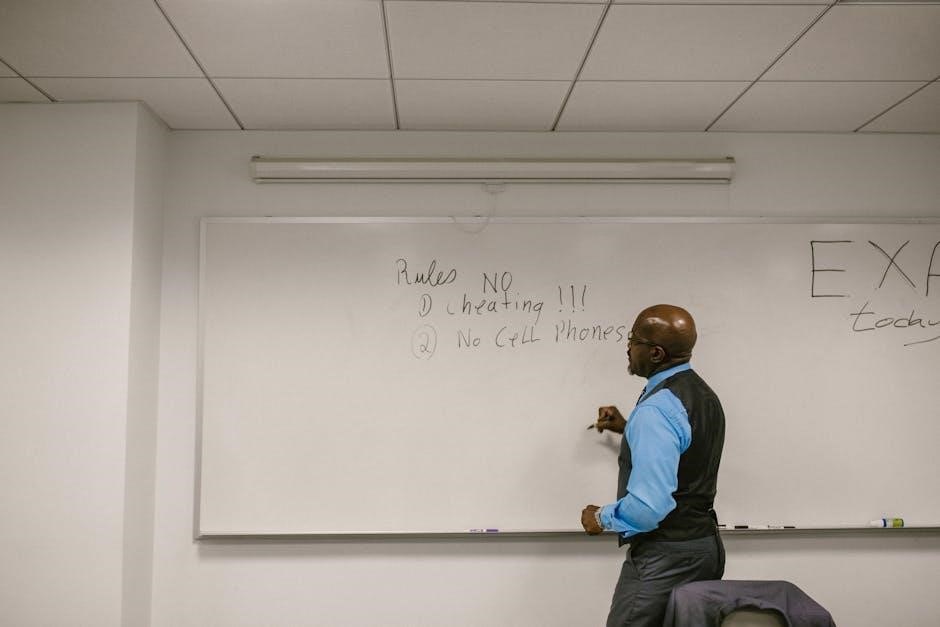Kickball is a fun, engaging game played with two teams, bases, and a large ball. Governed by the World Adult Kickball Association (WAKA), its rules ensure fair play and enjoyment for all participants. The objective is to score runs by kicking the ball and running around bases, similar to baseball. Official rules, including team composition and gameplay mechanics, are outlined in the WAKA rulebook, available as a downloadable PDF for easy access.
Overview of Kickball and Its Popularity
Kickball has gained widespread popularity as a fun, accessible sport for both adults and children. Played on a softball diamond, it combines elements of baseball with a focus on kicking a large ball. Governed by the World Adult Kickball Association (WAKA), the game is simple yet engaging, making it a favorite in recreational leagues worldwide. Its appeal lies in its minimal equipment requirements and emphasis on teamwork, attracting diverse groups and fostering social interaction. With clear rules and a structured format, kickball continues to grow as a beloved activity for players of all ages.
The Role of the World Adult Kickball Association (WAKA)
The World Adult Kickball Association (WAKA) serves as the governing body for adult kickball, establishing official rules and regulations. WAKA ensures standardized gameplay, safety, and sportsmanship across leagues; It provides resources, including the official rulebook, to facilitate organized play. By promoting consistency and fairness, WAKA has become the authority in kickball, fostering growth and enjoyment of the sport globally. Its guidelines help leagues operate smoothly, making kickball accessible and enjoyable for players worldwide.
The Gameplay Overview
Kickball involves two teams competing to score runs by kicking a ball and running around bases. The game combines elements of baseball with a focus on fun and accessibility.
Objective of the Game
The objective of kickball is to score more runs than the opposing team by kicking the ball and running around the bases. Players take turns kicking the ball, attempting to reach home plate safely. Each team fields 10 players, and the game is played over 7 innings or until a time limit is reached. Runs are scored when a player successfully circles all bases and returns to home plate. The team with the most runs at the end of the game wins, following rules set by the World Adult Kickball Association (WAKA).
Basic Structure: Teams, Bases, and the Ball
Kickball involves two teams, each with 10 players on the field. The game is played on a diamond-shaped field with four bases: first, second, third, and home plate. The official ball is a 10-inch red rubber ball, inflated to 1.5 pounds per square inch. Teams take turns kicking and fielding, with the kicking team sending one player at a time to kick the ball and attempt to run the bases. The fielding team works to get runners out and score runs in their turn. This structure ensures balanced and organized gameplay.

The Playing Field
The kickball field is diamond-shaped, with bases 60 feet apart and a pitching area 50 feet from home plate. The strike zone extends one foot on all sides of home plate.
Field Dimensions and Layout
The kickball field is a diamond shape with bases 60 feet apart. The distance from home plate to second base is 84 feet 10 1/4 inches. The pitching area is a 10-foot diameter circle centered 50 feet from home plate. Bases are positioned at each corner of the diamond, with a safety base at home plate to prevent collisions. The field layout ensures fair play and aligns with official WAKA standards, providing a consistent environment for all games.
Strike Zone and Safety Bases
The strike zone extends one foot on either side of home plate and one foot high. A box around the plate marks this zone, and any part of the ball within it is a strike. Safety bases, particularly at home plate, are designed to reduce collisions. These bases allow runners to safely reach home without direct contact with fielders. The rules ensure fair play and player safety, adhering to official WAKA standards for a fun and injury-free game.
Official Ball Specifications
The official kickball must be 10 inches in diameter when properly inflated to 1.5 pounds per square inch. It is typically red and features the WAKA logo. The ball’s size and pressure ensure consistent gameplay and safety. Using the correct ball is essential for fair play, as it maintains standard performance and durability. Teams must use the WAKA-approved kickball for all official games to adhere to regulations and ensure a fun, competitive experience for everyone involved.

Player Requirements and Rules
Teams must have a minimum of 10 players, with at least four women required on the field at all times. All players can kick, but no more than three men can kick consecutively. The kicking order must remain consistent, though fielders can be substituted while maintaining the gender ratio. Proper attire and adherence to these rules ensure fair and enjoyable gameplay for everyone involved.
Team Composition and Minimum Players
A kickball team must consist of at least 10 players, with a minimum of 8 players required to start a game. Teams can have up to 10 fielders, ensuring a balanced and fair game. At least four women must be present on the field at all times, maintaining the gender ratio rule. Substitutions are allowed, but the composition of the team must always adhere to these guidelines to ensure proper gameplay and sportsmanship. This structure promotes inclusivity and equal participation among all players.
Gender Rules in Kickball
Kickball games require teams to maintain a gender-balanced structure. A minimum of four women must be on the field at all times, ensuring inclusivity and fair participation. Additionally, no more than three men can kick consecutively, promoting equal opportunities for all players. These rules are designed to foster a fun and balanced environment, adhering to the guidelines set by the World Adult Kickball Association (WAKA). This ensures that everyone can enjoy the game while maintaining the spirit of sportsmanship and equality.
Gameplay Mechanics

Kickball involves teams of 10 fielders, with games lasting 7 innings. Players kick the ball and run bases to score runs, emphasizing fun and strategy. Bunting is allowed, and no more than three men can kick consecutively, ensuring balanced participation. The objective is to outscore the opposing team by the end of the innings, following rules set by the World Adult Kickball Association for fair play.
Kicking and Running Rules
Kicking is the core action in kickball, with players required to kick the ball below their waist. A foul occurs if the ball lands outside the field or the kicker misses twice. Runners must advance bases by kicking or reaching them safely. They can advance on hits, errors, or wild pitches. A runner is out if forced or tagged with the ball. A safety base at home plate prevents collisions, ensuring player safety while maintaining fair play dynamics during the game.
Scoring Runs and Innings
A run is scored when a player reaches home plate safely. Games typically consist of 7 innings, with each team kicking and playing defense in alternating innings. A new inning begins after three outs are recorded by the defensive team. The team with the most runs at the end of 7 innings wins. If the score is tied, the game continues until a winner is determined. Runs can be scored through kicks, errors, or forced advances, with all players required to touch each base before reaching home plate to ensure valid scoring.
Bunting and Forced Outs
Bunting is allowed in kickball, enabling offensive strategy by advancing runners. A forced out occurs when a runner must advance due to the ball being kicked or a play situation. If a runner fails to reach the next base before the ball is fielded, they are called out. Forced outs are common on infield hits or bunts, ensuring runners move promptly. Properly executed bunts can lead to successful base advancements, while forced outs help the defense maintain control of the game’s pace and scoring opportunities.
Rules for Specific Situations
Rules address fouls, dead balls, substitutions, and safety protocols, ensuring fair and safe gameplay during unexpected events like injuries or disputes.
Foul Balls and Dead Ball Situations
A foul ball occurs when the ball lands outside the field or is not kicked fairly. The referee signals a foul, and the kick is repeated. A dead ball situation pauses gameplay due to injuries, disputes, or equipment issues. The strike zone, one foot on either side of home plate, determines if a kick is a strike or foul. These rules ensure player safety and maintain fair play, allowing the game to resume smoothly after interruptions.

Substitutions and Field Changes
Substitutions in kickball allow teams to swap players between innings. Field changes must maintain a minimum of four women on the field at all times. Teams can change fielders, but the kicking order remains fixed. Substitutions are typically made between innings to ensure smooth gameplay. Any changes must be communicated to the referee to avoid disputes. These rules ensure fair play and maintain the integrity of the game, while allowing strategic adjustments to enhance team performance and adapt to game situations effectively.

Official Rules and Governance
The World Adult Kickball Association (WAKA) governs kickball with official rules ensuring fair play. Their rulebook, available as a PDF, outlines all game regulations and updates.
WAKA Rulebook and Updates
The World Adult Kickball Association (WAKA) maintains an official rulebook, available as a downloadable PDF, which outlines all game regulations. This document is regularly updated to reflect changes in gameplay, safety protocols, and organizational policies. Players and leagues are encouraged to refer to the latest version for accurate information. The rulebook covers essential aspects such as team composition, gameplay mechanics, and specific scenarios, ensuring consistency across all matches. Updates are communicated through official channels to keep the kickball community informed.
Referee Roles and Decision-Making
Referees play a crucial role in ensuring fair gameplay by enforcing rules and making decisions. At least one authorized official, often the Head Referee, oversees each game. Referees are responsible for calling plays, resolving disputes, and maintaining order. Their decisions are final and binding, with no room for argument. The World Adult Kickball Association (WAKA) emphasizes the importance of referee authority to uphold the integrity of the game. Referees also handle dead ball situations and ensure player safety, adhering to the official rulebook guidelines.

Safety and Sportsmanship
Safety and sportsmanship are essential in kickball. Players must respect others, follow rules, and ensure a fair, enjoyable game for everyone involved.
General Safety Guidelines
Kickball games must prioritize player safety to prevent injuries. Safety bases are mandatory to reduce collisions at home plate. Players should warm up properly and wear appropriate footwear. No metal cleats are allowed, and jewelry should be removed. The field must be inspected for hazards before play. First aid kits should be on hand, and supervision by trained officials is recommended. Teams are encouraged to follow all safety protocols outlined in the official WAKA rulebook to ensure a safe and enjoyable experience for everyone involved.
Code of Conduct for Players

Players must adhere to a code of conduct emphasizing respect, sportsmanship, and fair play. Unsportsmanlike behavior, such as taunting or intentional contact, is prohibited. All participants must follow WAKA rules and guidelines, ensuring a positive experience for everyone. Any violations may result in penalties or ejection from the game. Teams are encouraged to promote inclusivity and respect among players, umpires, and spectators. By upholding these standards, kickball remains a fun and enjoyable activity for all involved.
Kickball rules ensure a fun and fair experience for all players. By following WAKA guidelines and maintaining sportsmanship, participants can enjoy the game while promoting teamwork and camaraderie.

Importance of Following Official Rules
Adhering to official kickball rules ensures fair play, safety, and consistency across all games. The World Adult Kickball Association (WAKA) rulebook provides clear guidelines to prevent disputes and injuries. Following these rules promotes sportsmanship, maintains game integrity, and allows players to focus on enjoying the game. Official rules also ensure that all players, regardless of skill level, can participate fairly. By understanding and respecting these guidelines, everyone involved can have a positive and enjoyable kickball experience.

Final Tips for Enjoying Kickball
To maximize your kickball experience, focus on teamwork, communication, and sportsmanship. Familiarize yourself with the official rules to avoid confusion and ensure smooth gameplay. Stay hydrated, warm up properly, and respect all safety guidelines. Encourage your teammates, celebrate successes, and learn from mistakes. Embrace the social aspect of the game and enjoy the camaraderie with fellow players. Remember, kickball is a game meant for fun, so keep a positive attitude and make the most of your time on the field!
